I’ve been thinking a lot about philosophies related to ecofeminism, drawing parallels between the oppression and domination of marginalized groups (women, people of color, LGTBQIA, the poor) and the oppression and domination of Nature. Thus, my current creative interests lie in advocating for the spiritual and political liberation of both.
About the Artist
In 2006, I received my MFA from Rinehart School of Sculpture at the Maryland Institute College of Art where I was awarded MICA and Jack Kent Cooke Scholarships and a Jacob K. Javits Fellowship. Since graduating I have been an active participant in Baltimore’s local art scene. I am an adjunct III faculty member at Towson University and the Maryland Institute College of Art, as well as an independent curator. I was the director of exhibitions and curator at Goucher College for over ten years, where I programmed and mounted over 100 exhibitions. My work has been exhibited locally and nationally. Most recently I created a site-specific installation titled Forest Royalty for the Baltimore Museum of Art’s exhibit Baltimore, Addressed: Baker Artist Awards (Baltimore. MD 2022-2023). Other solo exhibitions include; sculptor-in-residence at Ladew Topiary Gardens (Jarrettsville, MD 2020), Schmucker Art Gallery at Gettysburg College (Gettysburg, PA 2017), the Creative Alliance (Baltimore, MD 2013), The Katzen, American University Museum, (Washington, DC 2007), Turchin Center for the Visual Arts, (Boone, NC 2005) where she received an Andy Warhol Foundation for the Visual Arts Grant, Urban Institute for Contemporary Arts, (Grand Rapids, MI 2005), and the Delaware Center for the Contemporary Arts, (Wilmington, DE 2004), among others. I am honored and humbled to be the recipient of several awards, most recently the Mary Sawyers Baker Artist Award for Interdisciplinary Art (2020). My work has been featured and reviewed in publications including Sculpture Magazine, The New York Times, City Paper, The Baltimore Sun, Baltimore Magazine, Maryland Life, and The Washington Post.Artist's Statement
In 2012, I began applying a thematically based, curatorial approach to my work, producing multiple works simultaneously, one informing the other. Thus, my creative practice has evolved to become that of a visual storyteller. My interdisciplinary methods include large-scale site-specific installation, sculpture, mixed media, video, projection, photography, and performance. Drawn to the natural world and the lived human experience, my work often investigates the universal themes of ecology, spirituality, and psychology. Seeking conceptual inspiration from the environment, people, histories, and personal experience, I produce projects that immerse the viewer in spaces where nature and artifice spring from and merge into one another, in doing so, I hope to offer the audience a place for quiet reprieve, where nature's beauty and wonder hold space for the connection and healing of all things. As a queer woman, I strive to create work that challenges the dominant narratives and encourages reflection on the relationship between humans and nature. Lately, I’ve been thinking a lot about philosophies related to ecofeminism, drawing parallels between the oppression and domination of marginalized groups (women, people of color, LGTBQIA, the poor) and the oppression and domination of Nature. Thus, my current creative interests lie in advocating for the spiritual and political liberation of both.Featured Work
Photos
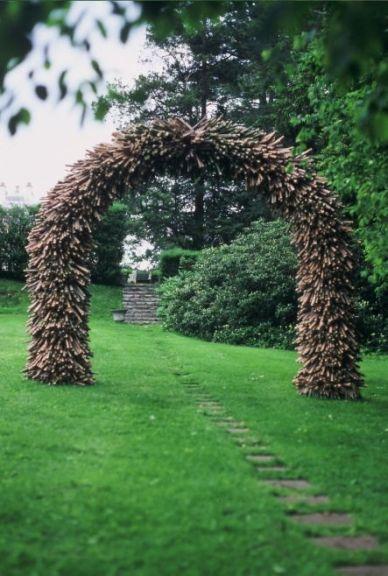
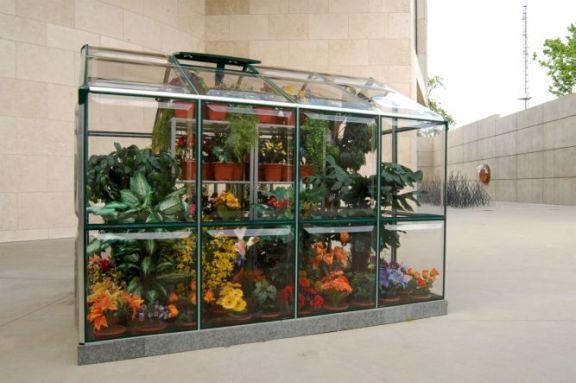
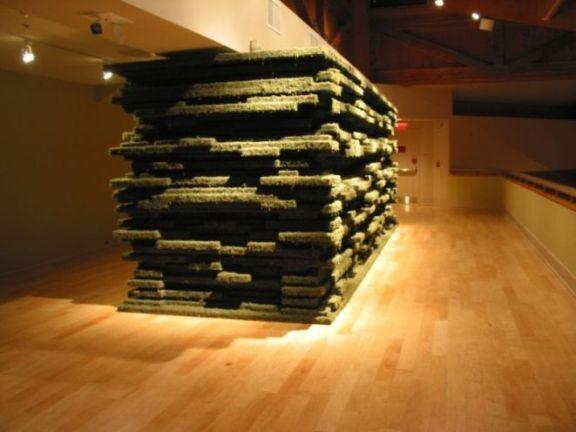
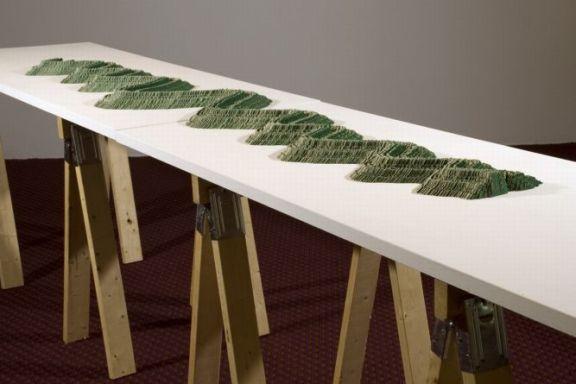
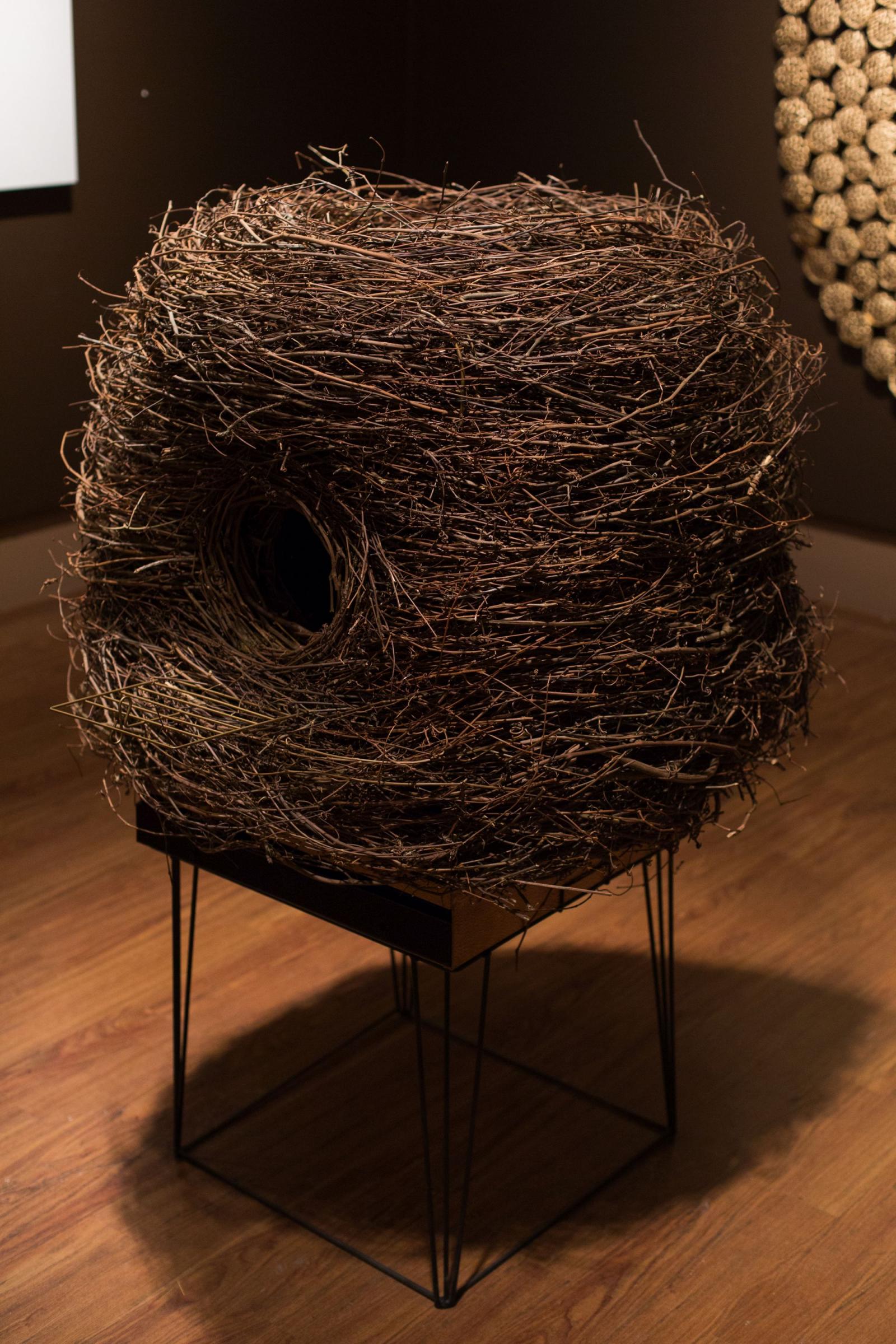
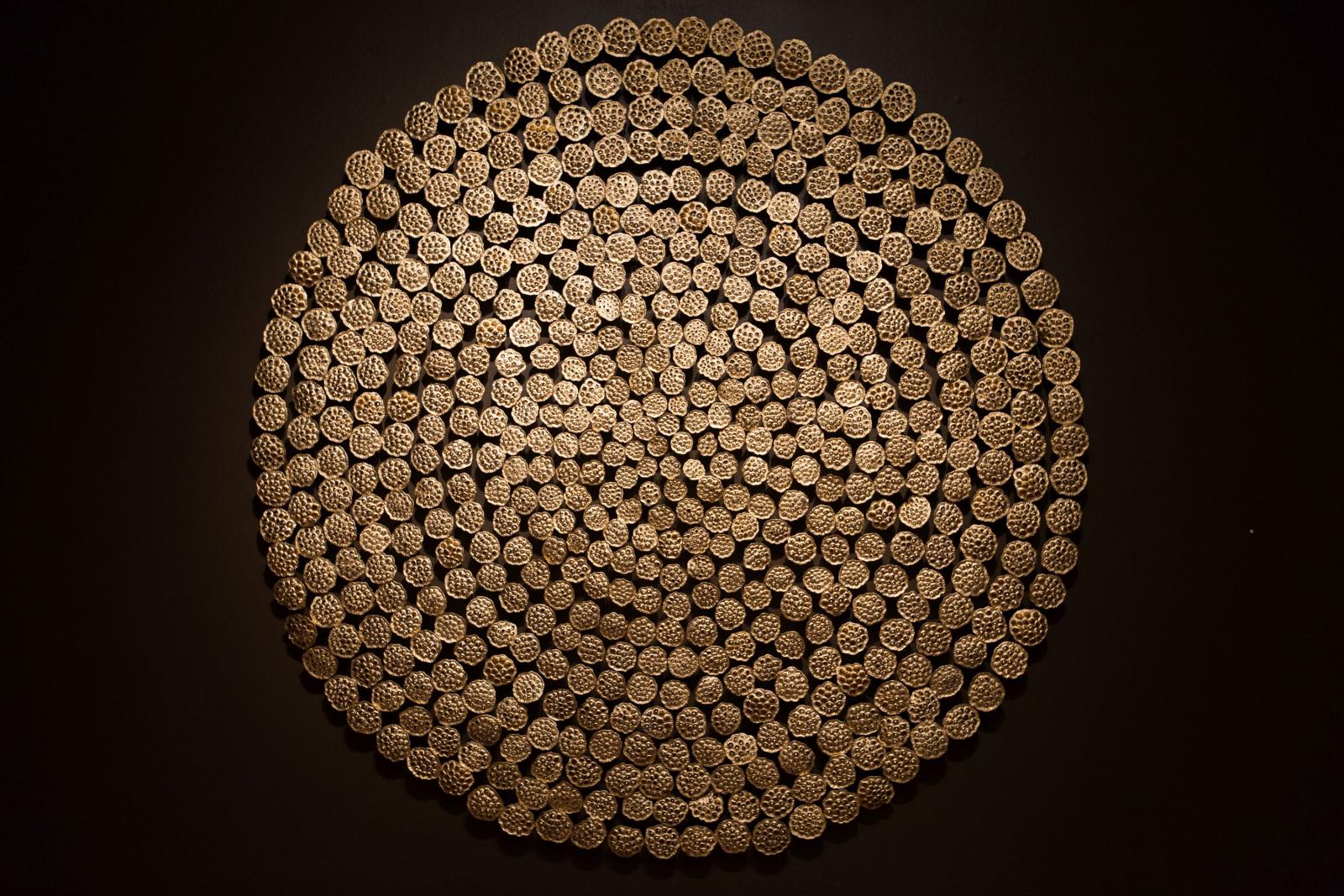
Featured Work: Photos
Verve
Bamboo, metal armature, and wire
2002
Site-specific installation, created for Johns Hopkins Universities Evergreen House. In order to bring people together to enjoy and promote the arts former Evergreen matron, Alice Warder Garrett converted the gymnasium into a private theater. Here she entertained friends with her own performances as well as hosted the Musical Art Quartet every spring and fall for nearly two decades.
The Peterson's, The Entwistle's, The Winkler's, The Façade
Gazebo, artificial ivy, second-hand artificial flowers
2007
Inspired by the onslaught of spousal murders which captured the attention of the media. In each of these three cases, the Peterson's, the Entwistle's and the Winkler's, families and friends were shocked by the murders. Each family did a very good job at keeping up appearances in other words, creating a fantastic fake façade which masked the turmoil that grew within.
Habitat
Foam, preserved moss and adhesive
2005
I created Habitat, a site-specific and site-responsive installation, for the Mezzanine Gallery at Appalachian State Universities Turchin Center for the Visual Arts. For this installation material, environment, form, and local ecology are united, creating an immersive experience within the gallery where sculpture and space appear to merge. Inspired by the endangered spruce-fir moss spider and its habitat, the piece draws on aspects of environmental concern as well as expresses local ecological properties.
Royal Pine
Pine Scented Air-fresheners, wood doors, saw horses
2005
Sculpture, referencing a topographical mountain range. Smelly indeed.
"A bird is safe in its nest - but that is not what its wings are made for." -Amit Ray
Vintage birdcage and twigs
2017
"There are days I drop words of comfort on myself like falling leaves and remember that it is enough to be taken care of by myself." -Brian Andreas
Our current cultural and political climate is fraught with tension, our lives increasingly more stressful, and the world more hectic. These truths demand our constant effort and attention. Thus, it’s important - and difficult – to take time to replenish our mental, physical, and emotional reservoirs. Nature offers humanity reprieve and provides pictorial and poetic narratives: a moss blanket comforts a broken soul; a nest bursts from and engulfs a birdcage; a large-scale, site-specific, wall mounted mandala comprised of a thousand golden lotus seedpods begs the viewers to find stillness in contemplation; a wall of multicolored baskets symbolize our need to constantly hold and care for ourselves, especially when difficult life experiences arise; and, two smaller mandalas – one made of seeds, the other of Bodhi (ficus religiosa) leaf skeletons – speak of ritual and meditation. Transformed into visual expressions, materials become metaphor for these psychological associations. Each work relies on the repetition and expansion of a fundamental unit to explore the relationship of the physical to the psychological. In all the works, less is more. Spare forms and conceptual innuendo swiftly carry each work into the bio-philosophic. They establish connections between the inside and outside of the body and mind to consider our larger relationship to the natural world. The organic matter featured in this body of work metaphorically symbolize our collective human fragility; our need to be cared for and healed.
Rising from a Dark Place
Gold lotus seed pods and metal rods
2017
"There are days I drop words of comfort on myself like falling leaves and remember that it is enough to be taken care of by myself." -Brian Andreas
Our current cultural and political climate is fraught with tension, our lives increasingly more stressful, and the world more hectic. These truths demand our constant effort and attention. Thus, it’s important - and difficult – to take time to replenish our mental, physical, and emotional reservoirs. Nature offers humanity reprieve and provides pictorial and poetic narratives: a moss blanket comforts a broken soul; a nest bursts from and engulfs a birdcage; a large-scale, site-specific, wall mounted mandala comprised of a thousand golden lotus seedpods begs the viewers to find stillness in contemplation; a wall of multicolored baskets symbolize our need to constantly hold and care for ourselves, especially when difficult life experiences arise; and, two smaller mandalas – one made of seeds, the other of Bodhi (ficus religiosa) leaf skeletons – speak of ritual and meditation. Transformed into visual expressions, materials become metaphor for these psychological associations. Each work relies on the repetition and expansion of a fundamental unit to explore the relationship of the physical to the psychological. In all the works, less is more. Spare forms and conceptual innuendo swiftly carry each work into the bio-philosophic. They establish connections between the inside and outside of the body and mind to consider our larger relationship to the natural world. The organic matter featured in this body of work metaphorically symbolize our collective human fragility; our need to be cared for and healed.
Videos
-
Embedded in the seed is the blossom waiting to unfold
See more information about Embedded in the seed is the blossom waiting to unfoldInspired by the abundance of seedpods that blanket Ladew’s Wildflower Meadow, Amussen renders the seed larger than life and draws parallels between nature and femininity, in her piece, Embedded in the seed is the blossom waiting to unfold.Medium: Armature, second-hand artificial plants and flowersYear: 2020Details: 42” x 48” x 48” -
Oval Library Topiary Folly
See more information about Oval Library Topiary FollyTaking cues from the ivy infiltrating the Oval Library, but also inspired by the follys, gardens, and topiaries found in Ladew’s gardens, Oval Library Topiary Folly, delightfully brings the inside out, a merger of both landscape and architecture. A large oval gazebo provides the framework for this structure, as again artificial ivy and flowers overtake the building. Most of these artificial flowers were bought second-hand, a deliberate choice by the artist.Medium: Gazebo, artificial ivy, second-hand artificial flowersYear: 2020Details: 9.5’ x 12.5’ x 9.5’ -
Checkmate
See more information about CheckmateWhile exploring Ladew Topiary Garden’s 22 acres of gardens and the historic Manor House, sculptor-in-residence, Laura Amussen found herself reminded of Mother Nature’s unwieldy propensity to consume abandoned or unattended structures and objects. In the Oval Library, a single sprig of ivy creeps through a grate on the floor. Visible through the window—just beyond the threshold—the ivy blankets the ground. Its presence threatening to overtake the inlaid drop-leaf gaming table and side chairs before making its way to the oval partner’s desk. One can easily imagine—if given time—the ivy swallowing these interior relics whole, as Mother Nature creates topiaries of Her own. Amussen’s piece Checkmate brings this playful fantasy to life. Artificial ivy spreads across the floor and over the furniture, leaving visible only traces of the structures beneath.Medium: Artificial Ivy and antique furnitureYear: 2020Details: Site-specific installation -
Forest Royalty
See more information about Forest RoyaltyIn March 2020 - when Covid lockdown began - I started hiking the same five-mile trail at Loch Raven Reservoir, almost every day. This allowed me to experience the slow daily shifts of the seasons and observe the multitude of fungi that exist, often fleetingly. I hiked that trail so many times, that even in the winter, when it was snowy and the trail was gone, I mostly knew where I was going. On my way in, I would allow my mind to wander, often I would be called off trail for one reason or another, only to be rewarded by finding the most magical mushrooms. At some point, I realized I was practicing a walking meditation, an act of present moment awareness. I started noticing the smallest details, the way nature was in a constant state of flux, birth followed by death, then birth again, incessant change. Through photography, I documented the minutiae of the daily shifts occurring on the forest floor, in particular, the fungi. Once at my destination - a beautiful peninsula overlooking the top of the dam - I would meditate. I would also hug a nearby Beech tree and pray to my ancestors. On my hike out I would spend thirty minutes thinking positive affirmations and another thirty thinking about what I was grateful for. When friends hiked with me, they joined along, it was magical; each of us taking turns sharing our most vulnerable thoughts and feelings. A much-needed moment of deep connection amidst rampant Covid induced isolation. As I continued these daily self-care rituals and documenting the shifts occurring on the forest floor, something inside of me shifted as well. We're not taught how to love ourselves or how to heal from trauma. I've been doing healing work for many years; I've struggled with addiction, childhood trauma, and loss. But the healing that occurred during those daily hikes, because of my spiritual practices, was monumental. In visually creating a snapshot of this personal journey for the exhibition, Baltimore, Addressed: Baker Artist Awards at the Baltimore Museum of Art, I hope to offer the audience a place for quiet reprieve, where nature's beauty and wonder hold space for the connection and healing of all things.Medium: Artificial trees, plants, and moss, wood, spray foam, foam, fabric, batting, thread, plastic, beeswax, yarn, cork, beads, gemstones, paint, cardboard, and wireYear: 2022Details: Site-specific installation

